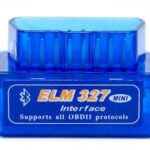You might have seen people sharing their boarding passes online, perhaps as a travel brag or just to share their journey. However, that seemingly innocuous barcode on your boarding pass holds more information than you might think, and exposing it could compromise your personal data. Let’s delve into why that barcode, easily scanned by devices from airport scanners to even a basic Car Radio Barcode Scanner app, can be a gateway to your flight details and personal information.
The barcode on your printed boarding pass isn’t just a random pattern; it’s encoded with specific data in PDF417 format, the standard for airline boarding passes. What’s crucial to understand is that PDF417 is an open and unencrypted format. This means anyone with a readily available PDF417 scanner can decode it. You can even find free apps like “PDF417 barcode scanner” on app stores, demonstrating just how accessible this technology is. Using such a scanner on a boarding pass barcode reveals a surprising amount of information, as illustrated below:
Let’s break down what kind of data is typically embedded within a boarding pass barcode and why it matters.
Decoding the Data: What Your Barcode Reveals
The information contained within the barcode, when decoded, usually includes the following details:
- Format Code (M) and Journey Leg (1): ‘M’ signifies the standard format, and ‘1’ indicates the first leg of your journey. This is relevant for connecting flights.
- Passenger Name: Your name is present in
FAMILYNAME/GIVENNAMEformat, clearly identifying you. - PNR (Passenger Name Record) or Booking Reference: This is a crucial piece of information, a unique code used to manage your booking. We’ll explore its significance further. In the example, it starts with ‘E’.
- Flight Details: This includes the origin and destination airports (e.g.,
SYDBNEfor Sydney to Brisbane), the airline code (QFfor Qantas), and the flight number (0544). - Date of Flight: Expressed as the day number of the year (e.g.,
159for June 8th). - Cabin Class: Indicated by a letter (e.g.,
Yfor Economy). - Seat Number: Your assigned seat (e.g.,
006A). - Sequence Number: This number reflects your check-in sequence (e.g.,
0034meaning you were the 34th person to check in). - Airline-Specific Data: This can include passenger status codes and potentially ticket numbers, which are airline-specific and vary in detail.
- Frequent Flyer Number: While less common now, frequent flyer numbers were previously often included in boarding pass barcodes.
While much of this information is printed visibly on the boarding pass, the barcode consolidates it in a machine-readable format, making it easily accessible with a scanner. The real vulnerability lies in the PNR.
The PNR Vulnerability: Your Key to Booking Management
The PNR, or Passenger Name Record, is the most sensitive piece of data hidden within your boarding pass barcode. Combined with your last name, it acts as a password to access your booking details on the airline’s website.
As shown in the example from Qantas’s “manage my booking” page (and similar systems are used by most airlines), entering your booking reference (PNR) and last name grants access to a wealth of personal information and booking controls. This access allows anyone with this information to:
- View Personal Details: See your phone number, email address (sometimes), and other contact information associated with the booking.
- Change Seat Selection: While perhaps minor, someone could change your pre-selected seat.
- Modify Meal Preferences: On international flights, meal requests can be altered.
- Cancel Flights: In a more malicious scenario, a person could potentially cancel your flight, even after you have checked in.
This level of access, gained simply from the barcode and publicly available scanners (or even theoretically a car radio barcode scanner app adapted for PDF417), highlights the potential privacy risks.
Protecting Your Boarding Pass and Personal Data
While the risk of widespread malicious exploitation from boarding pass barcodes might be low, it’s a good practice to be mindful of your personal data. Here’s how to enhance your boarding pass security:
- Avoid Sharing Boarding Pass Photos Online: Think twice before posting that celebratory airport lounge photo with your boarding pass visible. Blur or cover the barcode and PNR.
- Discard Boarding Passes Securely: Don’t simply throw away your boarding pass in public trash cans. Shred it or tear it up, especially if it contains your PNR clearly visible.
- Be Cautious in Public: Be aware of your surroundings when handling your boarding pass in public places.
While the convenience of digital boarding passes and online booking management is undeniable, understanding the information contained within your boarding pass barcode and the potential vulnerabilities is crucial for responsible travel in the digital age. Taking simple precautions can help safeguard your personal information and ensure your journey remains smooth and secure.

